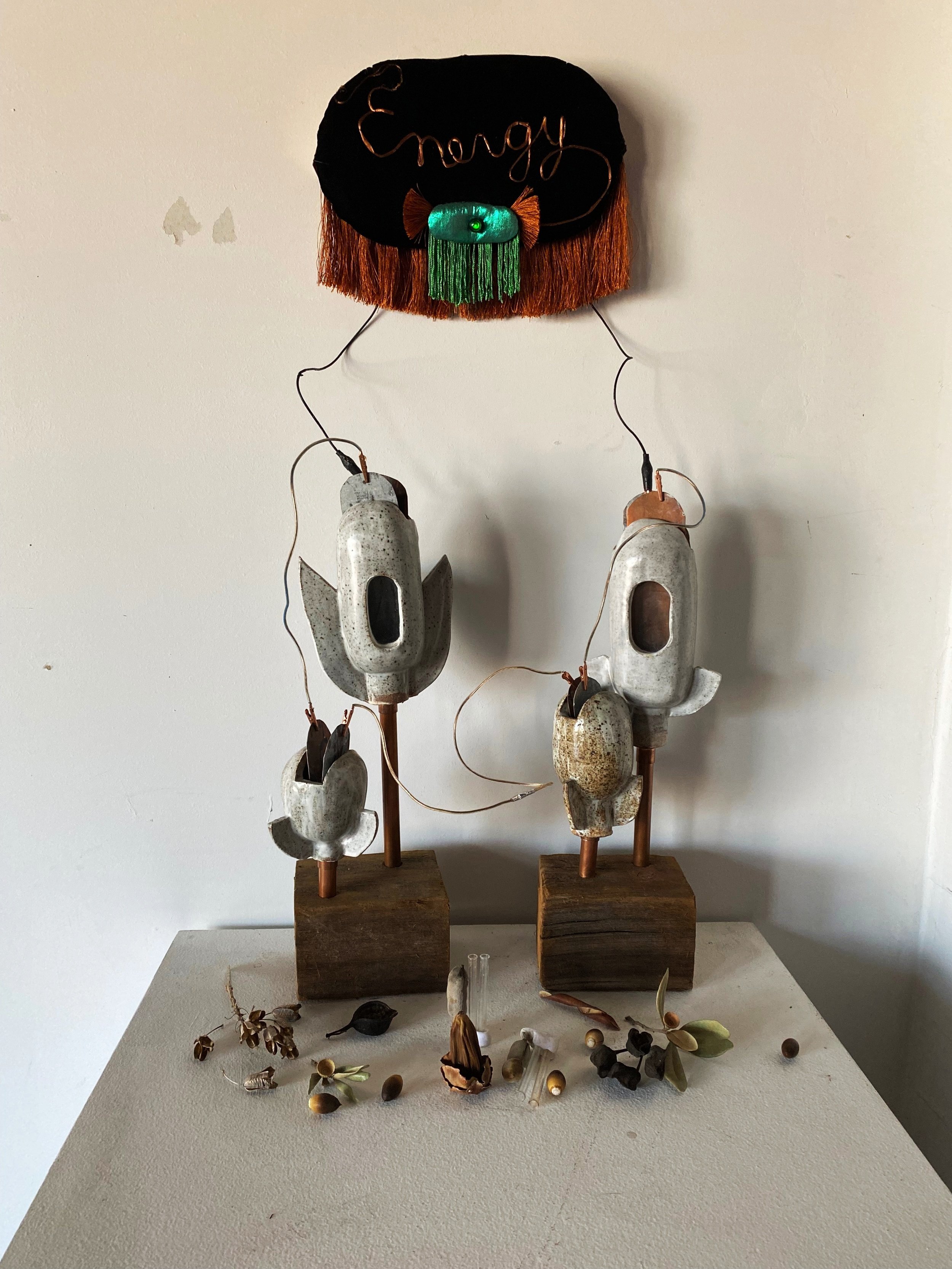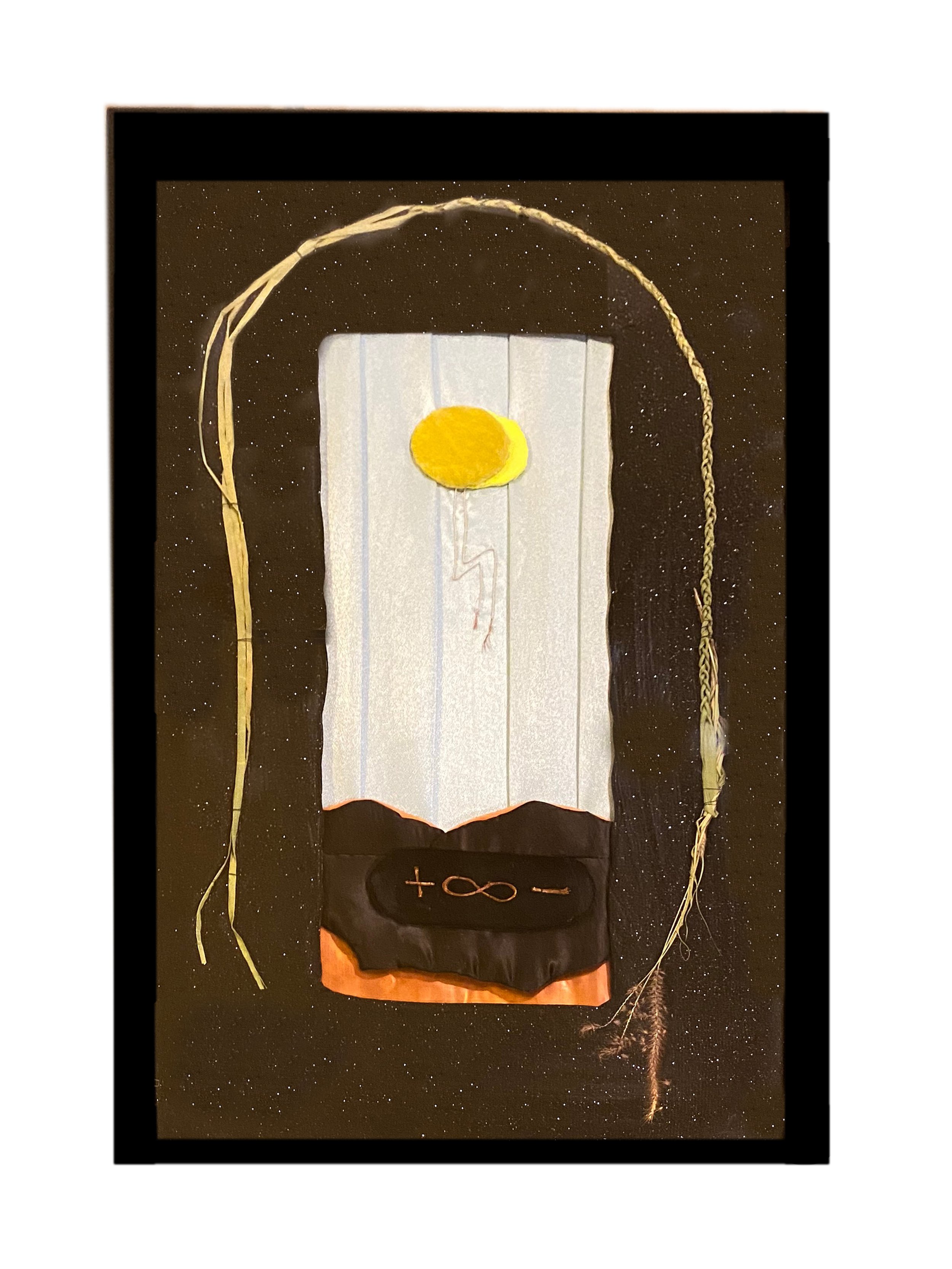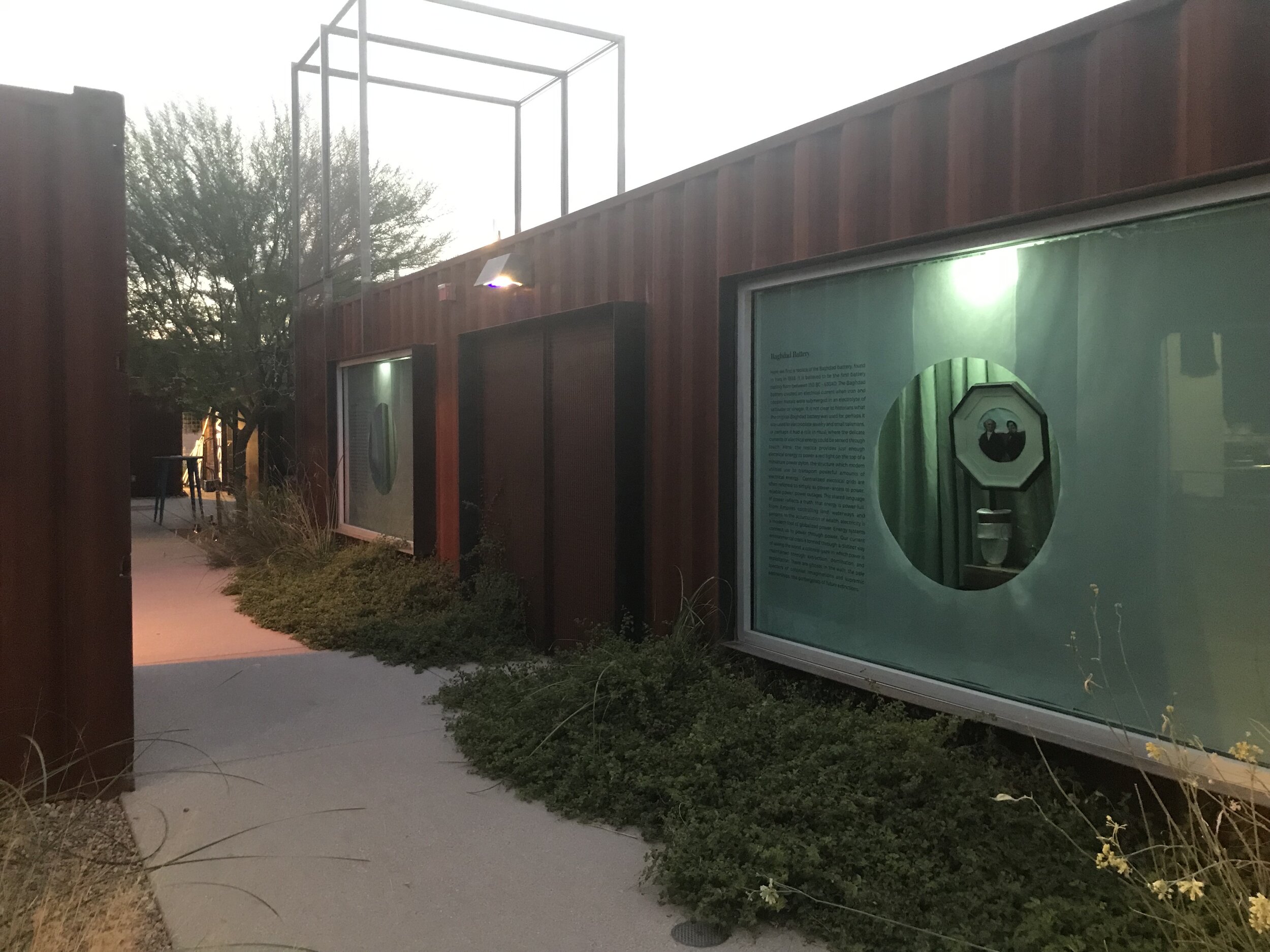Welcome to When a Place is a Battery. Perhaps you have arrived here by following a QR code? If so, great!
There should be a white clay object in front of you with two glass vials, a metal object, and 2 folded note card. Don’t touch anything yet!
Find a partner. Put on the headphones and attache the connector to your phone. Stand on opposite sides of the object, facing one another.
You are now ready to press play on the icon below. Follow the narrators instructions…
When a Place is a Battery is an interactive Object-Theatre for an audience of two. The public is invited to scan a QR code which plays a soundscape and narrated instructions for interacting with a handmade clay battery. Facing one another with the prop-object / battery between them, the soundscape leads participants through a series of actions, including secret actions which are different for the two participants. As they follow the audio instructions and interact with the contents before them, they move through time, from the geological and ancient process to futures yet to be know. Their attention and delicate labor results in completing the circuit of an organic battery, in doing so, they witness an LED light becoming illuminated, powered by the chemical reaction of clay, water, copper, zinc and participant’s actions. We are all participants in the energy rich systems and structures of our daily lives.
When a Place is a Battery is an interactive experience to expand our perceptions of energy-as-electricity and to value the ecological implications of who and what labors for us. Especially in these critical times as we strive for decarbonization and social-justice.
This work premiered at SNAKEBITE Creation Space in September, 2022. It is part of a larger body of work - The Magnetic Chamber which was shortlisted for both a Creative Capital Award and a Canadian Banting Fellowship.
I make batteries as talismans, reliquaries, and artifacts for greater energy-as-electricity awareness. My hope is that the making and experiencing of these objects help audiences perceive energy more sustainably and to make connections between nature, land, and power. This is particularly important as we as a nation, and as a border region, anticipate a future of battery powered homes, vehicles, and industry.
As a meditation and expression of my desire for kinder and more just (energy-rich) futures, hand-made batteries are small acts of resistance to what I consider to be Colonial Technologies. These are the systems, practices, and electronics that prioritize mass-consumption and capital gains over all else. The presence of Colonial Technologies in the borderlands can be seen and sensed in many places. From the Border Wall to industries of war, surveillance, aggressive mining, smelting waste, water rights, and energy-as-electricity (including electronics, waste, and non-recyclable energy material). Colonial Technologies and our engagement with them perpetuate these institutions into the future. Diversifying how we perceive, produce, and consume energy (utilitarian energy and that of human and more than human labor) offers performative possibility to transform the role of energy in our daily lives, imaginations, and futures.
WHEN A SEED IS A BATTERY
What is the difference between a seed and a traditional battery? On many levels they are the same thing – the small compact potential energy for the action that will occur from and through them. They both store energy potential, but a seed produces no waste. In order for battery-powered futures to not result in new mineral wars, aggressive extraction and contamination, battery technology must develop in a circular system of recycling, reuse and reduced consumption. Bio-batteries help us perceive and interact with energy-as-electricity in delicate and plant-like ways. In caring for a bio-battery we are encouraged to feel the scale of our energy use, the vastly different amounts of energy generated in delicate organic chemical reactions and the massive energy needed for industrial production. Bio-batteries encourage us to feel what is of value to us and how this valuing might transform power systems.
When a SEED IS A BATTERY is an ongoing project where I make batteries - clay, recycled metals, and assorted electrolytes. They appear in sites specific performances, installations and as interactive prop-objects. The purpose of hand-made batteries is allow new intra-actions with energy-as-electricity. Hand-made batteries expand perceptions of energy - the labor we do, as the labor of materials and the ways that technologies and systems create other relationships between us and the material world. This work began by me filming myself making a very basic clay powered bio battery. The energy generate by the battery was used to power a small Ardueno board that produced sound, I was able to change the quality of the sound by touching two copper plates. See stills from video below.
Hand-made batteries developed to become objects that could power small effects in installation settings. I consider these to be Prop-Objects which allow audiences to experience small electrical phenomena powering illumination and sound in poetic and insightful ways. This work was shortlisted for a Creative Capital Award and a Banting Fellowship in 2022. I continue to seek out opportunities to develop these prop-objects with electrical engineers. The idea is that, artist driven batteries which use humble and recyclable materials, at the very least, express a desire for recycled and not extractive batteries, and at the very best, inspire development in the field of future batteries.
BATTERY PROP-OBJECTS
A BATTERY MAKERS-MUSEUM (2020)
Developed during COVID through a month long Artist Residency in a shipping container in a public shopping area (MSA Annex in Tucson, AZ). In this installation I was exploring the possibilities of telematic (phone and geolocation technologies) and material storytelling to expand perceptions of energy-as-electricity, while also creating a safe socially-engaged experience during the time of Covid-19.
The installation consisted of handmade batteries displayed in the windows of the shipping container, land/scraper sound costumes which would occasionally leave the installation and make their way to the nearby riverbed, video projections, live battery-making rituals, and telematic soundscape and narrative. While the audience viewed these elements from outside of the shipping container, they were able to use their phones to listen to the soundscape and to participate in a narrated walk which led them from the installation site, to the contentious Caterpillar headquarter building, and the dry river bed of the Santa Cruz River. Together these three sites formed the scenography of the work; by day the installation functions as a “museum” for speculative batteries and Land/scraper armatures in a resting position (see images below), in the evening, the windows became viewing spaces for video projections, and objects in motion, Land/scrapers scraping, and handmade batteries powering small electrical effects.
Land/scrapers
Land/scrapers are armatures worn by performers. They are reminiscent of dinosaurs and are made out of VHS tape, the tails have piezo crystal pickups in them and copper amplifiers in their heads. When these ghost-dinosaurs walk, the scrapping of their tails is amplified out of theirs heads, like sonar, only here they are communicating what it feels like to be a land/scraper-extinction maker. They use solar charged batteries to power electronics.


























